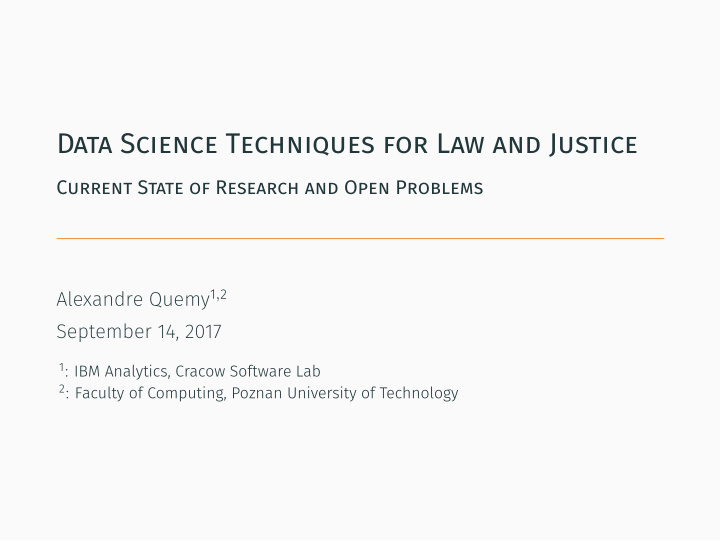



September 14, 2017 1 : IBM Analytics, Cracow Software Lab 2 : Faculty of Computing, Poznan University of Technology Data Science Techniques for Law and Justice Current State of Research and Open Problems Alexandre Quemy 1 , 2
Litterature Review Context & Problems Hypergraph CBR plan
context & problems
Law is complex: 1. Access to knowledge from different sources. 2. Collect, connect, and exploit knowledge . • grey areas of interpretation, • many exceptions, non-stationarity, • deductive, • inductive reasoning, • non-classical logic, • ... initial remarks & context Initial observation 3. Messy concept :
Even for Judges, Lawyers & Legal experts ! 1. More and more law texts include quantitative critera. 2. What is a good or bad justice decision? 3. How is really taken a justice decision? Lot of philosophical and sociological work but can data sci- ence help? initial remarks & context The problems
1. Predicting the outcome of a case given the legal environment. (Prediction) 2. Building a legal justification, given some facts, a set of law texts with the jurisprudence and an outcome. (Justification) dynamics and some criteria. (Decision) 4. Modifying the legal environment dynamics to match some criteria. (Control) the problems The problems 3. Taking the best decisions w.r.t. the legal environment
1. Why ”Prediction” exists since ”Justification” can provide an outcome? 2. ”Decision” and ”Control”, two sides of the same medal. 3. The litterature mostly study the ”Prediction”. the problems Remarks:
1 http://eur-lex.europa.eu/legal-content/EN/TXT/?uri=URISERV%3Al26118 illustration: “ The level of a fine must be sufficiently high both to punish the firms involved and to deter others from practices that infringe the competition rules. [...] The basic amount is calculated as a percentage of the value of the sales connected with the infringement [...]. The percentage of the value of sales is determined according to the gravity of the infringement (nature, combined market share of all the parties concerned, geographic scope, etc.) and may be as much as 30 %. ” 1
1. 67.4% correct prediction for judges 2. 58% correct prediction for cases the problems How hard is Prediction? Best legal experts on SCOTUS [ ? ]:
Research to Business, why does it matter ? 1. 1,300,000 licensed attorneys in the United States. 2. 58 million consumers in the U.S. sought an attorney. 3. 200 law schools. • around 50 law universities market landscape for legal analytics In US: In France: • 60000 lawyers, +41% in 10 years , 8355 judges, • in 2014, 791.448 basic missions for juridical help. • legal analytic is a priority axis of development
As February 2016: ”The total addressable market for legal software – both departments spend $1.5 billion annually on 11 types of software—from matter management to compliance to legal all technology segments are growing.” — InsideCounsel market size: a brief review corporate law departments and law firms—is 15.9 billion annually ; the market spends $3 billion each year; law analytics – in a market with a $6.5 billion potential and; while
market size: corporate legal software
litterature review
4. ... predictive models Plenty of approaches: 1. Stochastic Block Model [ ? ]: 77% 2. NLP + SVM [ ? ]: 79% 3. Random Forest [ ? ]: 69.7%
1. Two categories: LK vs non LK. 2. Realism conforted in both! predictive models Remarks: 3. Not a single player game! [ ? , ? ]
All “predictions” are not equals! 1. General 2. Robust 3. Fully predictive predictive models And the winner is... Random Forest [ ? ]
1. Search for the most related past cases, either by filtering the irrelevant cases or selecting the closest ones depending on a metric and a KNN algorithm. 2. Adapt the best case solution to the new case. 3. Evaluate and revise the proposed solution, including at least why the solution is not satisfying. 4. Integrate the solution to the database. case-based reasoning CBR cycle [ ? ]:
1. similarity and relevance of precedent cases are dynamic, 2. non-stationary as social and governmental laws evolve case-based reasoning Perform better than Rule-based [ ? ] but: Novel approach: learning rules a set of similar cases, then predict and justify with them [ ? ].
1. Defining the arguments and the relation(s) between them. 2. Valuating the arguments, etc. abstract argumentation AA [ ? ] = Toolbox for non-monotonic reasoning. AA cycle[ ? ]: 3. Selecting some arguments using some semantic .
2. Never applied on real data! 1. Promising but very normative. 3. Good at providing explanation. abstract argumentation
AA-CBR abstract argumentation 1. Arguments as past cases [ ? , ? ], 2. Rule learnt from past cases [ ? ]
market size and segments
hypergraph cbr
the end
Questions? Thank you for your attention! the end
Recommend
More recommend